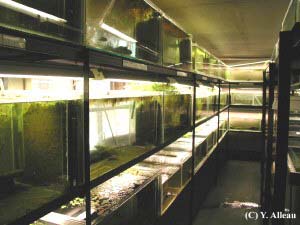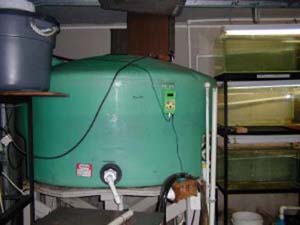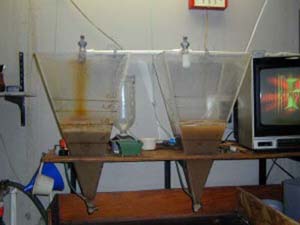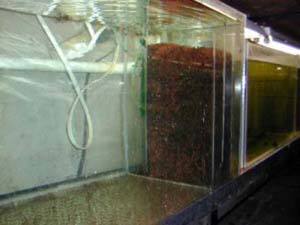|
|
 |
 |
|
APISTOGRAMMA: KEEPING AND MAINTENANCE
|
|
|
 |
 |
|
text by David P. Soares
fotos by Dr. Uwe Römer
|
|
|
 |
 |
|
When I first started keeping 'Apistos' (South American dwarf cichlids of the genus Apistogramma)
I didn't know anything about them. When I managed to get a hold of some, I would throw them in a tank with some water and wait around for something to happen. Needless to say, nothing ever did. I went through a lot
of fish in those days. I wasn't killing them in great numbers, but I was not producing any either. I had a great pair of Apistogramma nijsseni that would spawn on a regular basis, once every 10 days or so and I never saw any free-swimming fry throughout the whole time I had them.
|
|
|
 |
 |
|
As a result of this I decided that I needed to know a little bit more about
these fish. So I started bugging people on the telephone, and reading everything I could about the fish and the water conditions they live in. At the very beginning I learned some things that enabled me
to keep them longer and to spawn them. I also found that some of what I learned was adequate, but not good enough.
|
|
 |
 |
|
Tanks- there is a lot of material in aquarium literature about tank size and how it
relates to the fish. In most of the literature you will find that large tanks are recommended for large fish and small tanks for smaller fish. I remember one line that stated that Apistogramma are perfect apartment dwellers because you can keep them in small tanks. Well, this is true, to a certain extent. You can keep them in small tanks, and they will live and breed in there. What you won't see, however, is Apistogramma as they really are in nature.
|
 |
|
|
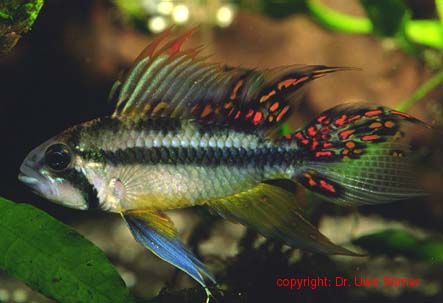 |
 |
 |
|
Uwe Römer has found, in studying Apistogramma populations in the wild, that these little fish sometimes live in a fairly crowded environment. Perhaps as many as a thousand fish in an area of nine square meters, with leaf litter up to one meter thick on the bottom. You cannot duplicate these conditions in a small aquarium, but you can in a large one. I keep my fish in tanks from 30 gallons to 150 gallons. Large tanks provide many advantages. They are easier to maintain, it is easier to maintain the proper pH and hardness, it is easier to control the effects of ammonia and nitrites, and you will see the fish act in a way that more closely resembles their behaviour in the wild. I have as many as 135 Apistogramma juruensis living in a 20-gallon aquarium. At present, I have around 700 Apistogramma cacatuoides in a 150-gallon tank.
|
|
|
 |
 |
|
Of course, to have this many fish in a tank it must have the correct
environment. I achieve this in one of two ways. My aquariums have either lots of wood, rocks, and plants, or wood rocks and leaf-litter. Follow the usual precautions with the wood and rocks - make sure
they are clean (sterile is best). With the rocks, don't use any types that will alter the chemistry of the water (i.e. limestone). The plants I use are pygmy chain swords and Indian fern, but any plant
that you do well with is fine. For spawning caves, I use the little 1 1/2"-2" plastic planting pots that are available at most nurseries. They are cheaper than other kinds, and you can get some
that are green, which kind of blends in with the environment. As often as not, though, the fish will spawn on a rock or a log. Put the caves in though, the fish still like them.
|
|
|
|
|
 |
 |
|
The most important component of an Apistogramma tank is the water. There are three things about the water that have to be right: hardness, pH, and cleanliness. I am fortunate when it comes to the water I get from the tap. It is snowmelt, right off the Cascade mountain range in Oregon. It is almost, but not quite good enough to keep Apistogramma in without any conditioning at all (100 ppm hardness and a pH of 6.5). Because in some cases it is not quite good enough I still run it through an R.O. (reverse osmosis) filter. Ion exchange is OK, but I don't like recharging them or having to get new resins when they're used up. Besides, with my tap water, I have yet to wear out the membrane in my R.O. filter!
|
|
 |
 |
|
Although I know some very competent Apistogramma keepers who use straight R.O. water for their fish, I mix mine with tap water to get a hardness of 10ppm. The next thing I do is treat the water with Sodium Bisulphate to bring the pH of my water down to 4.5. I also use peat in my filters, and leaves (either oak or beech) to bring the pH down. However, I have found that these two natural methods won't get the pH as low as I like it, so I supplement with the chemical alteration. I like to end up with a pH of 5.0 to 5.5 for most of my fish. The fish in the Apistogramma pertensis / Apistogramma iniridae-complex
seem to like it lower, around 4.5 pH.
|
 |
 |
|
Now that you have some idea as to the keeping of Apistos, here are a few
questions I get asked a lot - "Which ones?" and "How many?". Some Apistos seem to be a bit more forgiving than others. Apistogramma cacatuoides, Apistogramma steindachneri, Apistogramma macmasteri and Apistogramma sp. „Schwarzsaum” could all be considered good fish for starting out. However, if given the right conditions, most Apistogramma will take nicely to the aquarium situation.
|
 |
 |
 |
 |
|
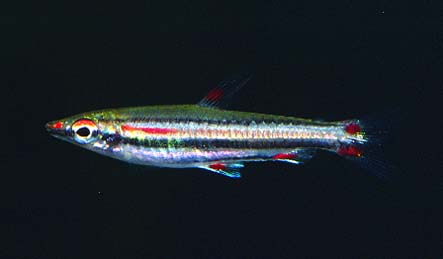 |
|
|
|
Apistogramma are great fish to keep with other fish fish like smaller Killies, Characines or Catfish. While territorial, they do not go to any extremes in defending their territory. One thing should be kept in mind, however, is that Apistogramma are divided into complexes within the genus (read Cichlid Atlas 2 for details!), for example the Apistogramma regani-complex, Apistogramma macmasteri-complex, Apistogramma
agassizii-complex etc. These complexes include fish, which are or seem to be closely related. In the Apistogramma agassizii complex for example there are Apistogramma agassizii,
Apistogramma bitaeniata, Apistogramma elizabethae, Apistogramma gephyra, Apistogramma mendezi, and Apistogramma paucisquamis. In the Apistogramma cacatuoides-complex, there are Apistogramma cacatuoides, Apistogramma juruensis, Apistogramma luelingi and
so on... While most males within the complexes are still comparatively easy to determine, it may give you a big headache to figure out the females. If you mix fish within the same complex in a community
tank, you may never get the females sorted again. And under such “forced conditions” - as scientist would call this type of tank setup - you could get some fireworks or some hybridisation (to be avoided
at all costs). Other than that, no problem.
Apistogramma are great little fish to keep and with a little care, and providing them with the right conditions, you can have a lot of fun with them. Give them a try and good luck!!!!!!!
|
|
|
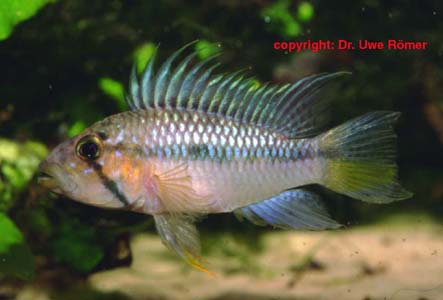 |
|
|
|
back to the top
|
|
|
|
|















